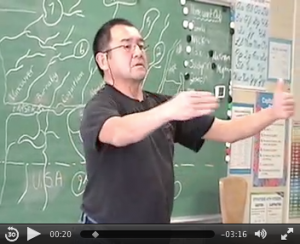Environmental Stewardship
Teacher Note: Depending on the length of class time available, this lesson may take 2-3 sessions to complete.
Learning Outcome
Students evaluate the human impacts on local ecosystems.
Steps to the Lesson
- Listen to an audio recording of a speech by Chief Seattle.
- Discuss main ideas of the speech with a class brainstorm.
- Preview a list of phrases from a video presentation.
- Watch a video on Salmon Stewardship in the Fraser River.
- Research articles and conduct a Jigsaw Instructional Activity.
- Complete a Thinking Yes/Thinking No activity on an issue concerning the Fraser River.
- Create a piece of written text about the importance of taking care of the environment.
- Reflect on new understanding.
CONNECT
Goal
Students will gain an understanding of stewardship through an Aboriginal World View.
Task
Students will write a piece of written text (journal reflection, letter, poem, speech) which sends a message to others about the importance of taking care of our environment.
Activate Prior Knowledge:
Part One
In 1854, Chief Seattle, a leader of the Suquamish and Duwamish First Nations in Washington State, gave a speech at a large outdoor gathering in Seattle. There have been many versions re-written of the speech since then (by other authors) but the speech has been widely cited as ‘a powerful, bittersweet plea for respect of Native American rights and environmental values.’
(Historylink.org)
For more information on Chief Seattle’s speech, please visit the HistoryLink.org website.
Students listen to the following audio recording of Chief Seattle’s speech. Credits for this recording are as follows:
Reader: Lekeyten (Kwantlen First Nation)
Kwantlen Song: Lekeyten, Cheryl and Brandon Gabriel (accompanied by Bryan Nelson)
– Used with permission from Susan Jeffers (Brother Eagle, Sister Sky) –
Note: This audio recording is used with permission from the Kwantlen Nation and is to be used solely for the purpose of the Aboriginal Curriculum Integration Project.
While listening to the audio recording, students track their thinking and highlight five key points from the speech using a What’s Important and Why sheet. Questions students should consider include: What is Chief Seattle’s message? What were his concerns?
Reminder: It is important to stop throughout the recording and give students (A/B partners) opportunity to talk or respond to the audio.

(Story Length: 10 mins)
Click here to Read Transcript
Once the audio recording has been played through and students have completed their What’s Important and Why sheets, students compare their thoughts in A/B partners and then report to the whole class. Teachers can then highlight key class ideas and themes with a brainstorm on the board.
Part Two
Students will now watch a video presented by Lekeyten of the Kwantlen First Nation.
Teachers distribute a list of phrases from Lekeyten’s presentation. In A/B partners or small groups, students read the phrases and share their predictions about what themes will be presented in the video.
Predict and Question:
Ask the students what questions they may have about environmental stewardship and the stewardship of salmon species. What are they wondering about?
PROCESS
Video
Distribute a second What’s Important and Why sheet for the students to track their thinking and identify five important facts from the following video on salmon stewardship.
Reminder: It is important to stop throughout the video and give students (A/B partners) opportunity to talk or respond to the video.

Click above to view video
Break students into groups of five. Teachers print out and distribute information from the following links.
Fish in a Ditch
Threats Facing the Fraser River
BC’s Miracle of the Fishes
TBuck Suzuki Environmental Foundation Brochure (Part One)
TBuck Suzuki Environmental Foundation Brochure (Part Two)
Give each group one article and do a Jigsaw activity. For information on how to do the jigsaw strategy visit the following link:
Jigsaw Instructional Strategy
Once students have completed the Jigsaw strategy, using the new information they have just learned, they complete a Thinking Yes/Thinking No sheet considering the question “Are human actions solely to blame for disappearance of Fraser River salmon?”. Students should write information showing both sides of the question on their Thinking Yes/Thinking No sheet.
TRANSFORM
Chief Seattle had a great deal of insight into the problems and challenges that were to come in the future. Review the text of Chief Seattle’s speech and consider some of the main ideas that Chief Seattle shared in his speech. For example, consider the following ideas from the text:
– What ever befalls the earth befalls the sons and daughters of the earth.
– This we know. The Earth does not belong to us, we belong to the earth.
– We did not weave the web of life, we are merely a strand in it. Whatever we do to the earth we do to ourselves.
Taking the text of Chief Seattle’s speech and Lekeyten’s words into account, students now create an original written piece of text that sends a message to others about the importance of taking care of our environment. The written text may consist of the following:
- Journal Reflection
- Letter to a local newspaper
- Speech to be presented in front of the class or school assembly
- Poem (Free verse or rhyming stanzas)
REFLECT
On the back of their ‘What’s Important and Why’ sheets, in a journal, or on a separate piece of paper, students write a reflection on how their attitude towards salmon stewardship and environmental stewardship has changed. What ideas presented in the audio and video recordings impacted their thinking the most?
Extend learning or next lesson
Invite visitors from local environmental groups to discuss human impacts on local lakes, rivers, and tributaries. If this isn’t possible, students locate and present articles that demonstrate local, regional, or national initiatives which help the environment.



